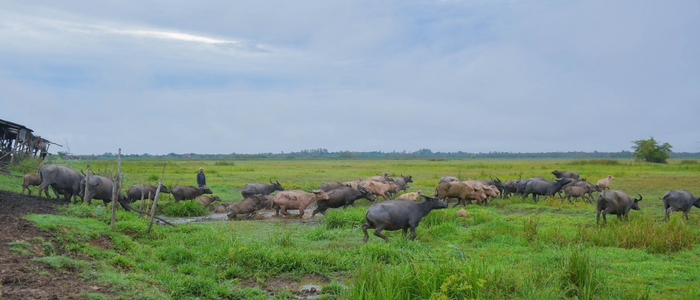Thale Noi wetland buffalo pastoral agro-eco-system, Thailand
GIAHS since 2022

Detailed Information | Partners | Annexes |
|---|
Global importance
The main distinctive feature of the Buffalo Pastoral System lies in the strong mutual interactivity among humans, animals, biodiversity, ecosystems, and the environment. Buffaloes provide ecosystem services that ensure the conservation of biodiversity and the landscape. They also reduce the risk of fires and support the overall system through nutrient cycles.
In addition, the Kuan Ki Sian Swamp Forest, located in the GIAHS site, is an important nesting site for waterbirds, both migratory and non-migratory species and an important habitat for several mammals, especially the ‘Fishing cat’ and Hairy-nosed Otter which requires urgent conservation interventions. Buffaloes’ role is key as their trampling continuously changes the local topography, providing niches and habitats for the local biodiversity and benefiting particularly the endemic and migratory birds.
Food and livelihood security
Buffalo pastoralism is the backbone of food and livelihood security of local communities. Indeed, throughout the year, pastoralists engage in a range of integrated livelihood activities such as rice farming, fishing, handicraft weaving, gathering of forest resources, tourism services, and other temporary jobs and small businesses, for alternative sources of income. Thus, during the monsoon season, when fish is more abundant, pastoralists become fisherfolk or when the dry season arrives pastoralists also become farmers.
Buffalo pastoralism makes an important indirect contribution to local food security as the sale of buffaloes is an important source of individual household income. Meanwhile, the more regular incomes earned from other livelihood activities, such as farming, fishing, and tourism, tend to be used for daily household consumption.
Agrobiodiversity
Swamp buffaloes (Bubalis bubalis) are Indigenous to Thailand and enjoy a special recognition in Thai culture and society. Besides buffalo rearing, pastoralists also cultivate home gardens with vegetables and rainfed rice, among which many varieties are local and endemic. One specific feature of the site is that wild rice relatives are grown together with domesticated ones allowing them to enrich and adapt the local cultivars.
The traditional practices of Thale Noi buffalo pastoralism are fundamental for the conservation and sustainable use of the highly bio-diverse local natural resources. Over 1,170 flora and fauna species have been discovered with aquatic vegetation being prominent. Up to 187 water bird species including migratory and non-migratory birds have been observed and depend on the symbiotic relation with the buffaloes’ system.
Local and traditional knowledge systems
Buffaloes are herded either free-range or with pens where animals are sheltered at night. During the monsoon season, buffaloes are kept in sheds, typically built 1.5 m above ground. Herders lead their animals out to the grazing areas through the flooded fields and bring them back before nightfall. Traditional veterinary, botanical knowledge and practices have been handed down from generation to generation to provide natural cures for the buffaloes.
Over the centuries, survival in the wetland of Thale Noi has depended on shared access to scarce resources. Buffalo husbandry in Thale Noi is characterized by communal sharing and management. Pastoralists herd their animals through communal resource-sharing by forming groups of 2 to 10 members. A set of commonly agreed rules and regulations provides guidelines for common and sustainable use of natural resources as well as shared tasks in the field.
Besides, pastoralists also rely on a rich knowledge of fisheries. The ‘Giant Net’, or ‘Yo Yak’, is a particular piece of fishing equipment used to catch aquatic animals. The uniqueness of this device lies in its exceptional weight and size and in its ingenious construction technique, developed using traditional local knowledge and wisdom.
Cultures, value systems and social organizations
Local culture and value systems are deeply influenced by buffalo pastoralism and embedded in traditional knowledge of sustainable resource management and ecosystem preservation. The close relationship between buffaloes and Thai farmers is reflected in several traditional Thai lyrics and songs, music instruments, festivals, rituals, gastronomy, etc.
The social organization of local communities reflects the traditional practice of communal management of natural resources and exchange of knowledge and benefits among community members. It is also characterized by a widely perceived sense of unity. Overall, pastoralists work in groups with a strong team mentality.
Landscapes and waterscapes features
The biophysical structure and functional relationships of the Thale Noi wetland are determined by flooding associated with the annual Asian monsoon. For this reason, the main features of Thale Noi landscape are the seasonal changes of the wetlands, the extraordinary scenic beauty and the high levels of biodiversity.
For centuries, this highly dynamic ecosystem, with high biodiversity and high primary productive capacity, has supported a range of human livelihood activities. These human activities - deeply rooted in traditional environmental knowledge – have contributed to the creation of these unique landscape and waterscape features, which are nowadays increasingly appreciated as a high value tourism destination, particularly for eco-tourism and experiential tourism.

